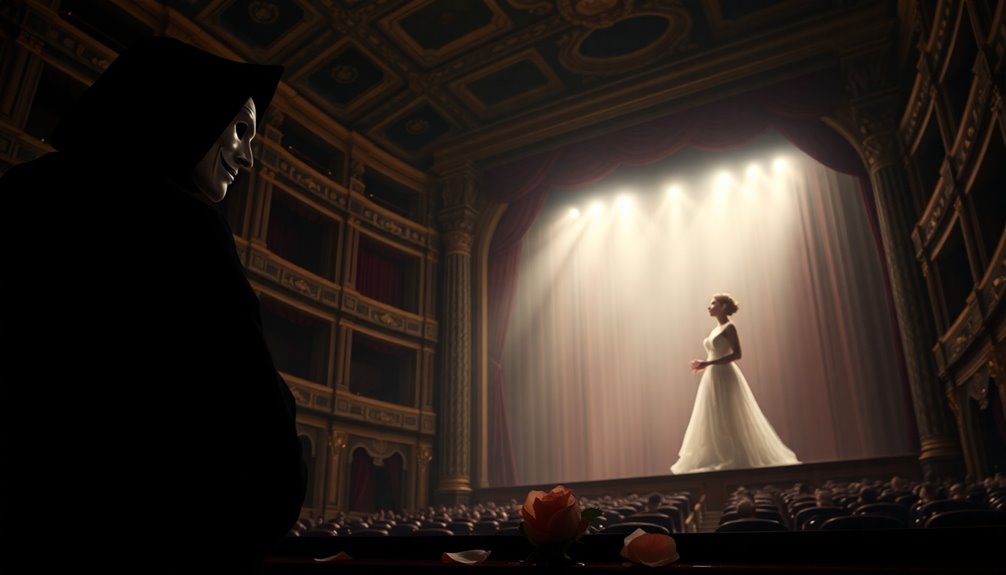In "The Phantom of the Opera," you uncover a gripping tale of love and obsession set against the backdrop of the Paris Opera House. The mysterious Phantom fixates on the talented Christine Daaé, propelling her from chorus girl to star, yet his intense desire leads to manipulation and chaos. As Christine navigates her love triangle with Raoul and the Phantom, you see the emotional turmoil and power imbalances that arise. This story explores the darker side of passion, revealing how longing can spiral into madness. Keep following along to discover the profound legacy left by these characters.
Overview of the Phantom
The Phantom, a mysterious figure haunting the Paris Opera House, captivates and terrifies those around him. His phantom identity is shrouded in secrecy, evoking both fear and curiosity.
You can't help but feel the weight of his obsession, particularly toward Christine Daaé, a talented young soprano. This obsession drives him to manipulate events behind the scenes, often with dire consequences for those who cross him. The intricate plots he weaves highlight his psychological tension and the moral ambiguity of his actions. His actions mirror the layers of deceit and betrayal found in complex narratives, where personal motives lead to unexpected outcomes.
As you explore deeper into his world, you realize that his love is twisted by loneliness and despair. The Phantom's tragic backstory reveals how isolation fuels his madness, making you question the fine line between passion and obsession.
Ultimately, you see the darkness lurking beneath his haunting melodies and the chaos he leaves in his wake. The Phantom's story serves as a cautionary tale about the destructive power of obsession, illustrating how love can lead to manipulation and tragedy.
Christine Daaé's Rise to Fame
Haunting melodies and an enchanting presence propel Christine Daaé into the spotlight of the Paris Opera House.
You can't help but be captivated by Christine's talent as she dazzles audiences with her voice, showcasing a rare gift that few possess.
Her journey begins in the shadows, where she's mentored by the mysterious Phantom, but it's her determination and hard work that truly shine. This dedication to her art reflects the spirit of resilience against extreme adversity, much like Louis Zamperini's survival story during WWII. Christine's emotional struggles parallel those of Tita De La Garza, who channels her feelings into cooking, serving as a testament to the power of self-expression.
As she navigates the challenges of the opera world, Christine's commitment to her craft draws attention from influential figures, including Raoul.
Each performance marks a step forward in her ascent, transforming her from a mere chorus girl into a star.
Through perseverance and passion, Christine embodies the essence of a true artist, capturing hearts along the way.
In many ways, her story mirrors those of strong female protagonists who have transformed their circumstances through resilience and talent.
The Phantom's Obsession
Obsession weaves a dark thread through the story of the Phantom, whose intense fixation on Christine Daaé drives him to extremes.
You see the Phantom's psychology unfold, revealing obsessive behavior rooted in emotional turmoil. His love's darkness blinds him to the consequences of his tragic obsession, as he clings to complex motivations that warp his sense of reality. The narrative echoes the theme of fear and courage, highlighting the internal struggles faced by characters in their desperate situations.
Isolated from the world, the effects of his loneliness foster unhealthy attachments that spiral into desperation. Instead of nurturing genuine connection, he becomes a prisoner of his own making, unable to let go of the idealized image of Christine. This emotional turmoil illustrates the dangers of unchecked fixation, demonstrating how obsession can consume an individual.
As you explore his character, you can't help but feel the weight of his obsession, a haunting reminder of love's darker side. The echoes of his actions mirror the psychological depth found in Gothic literature, illustrating how obsession can intertwine with identity and fear.
The Paris Opera House
The Paris Opera House isn't just a backdrop; it's a character in its own right, showcasing stunning architectural grandeur that captures your imagination.
With its haunted legends and myths, the building adds a layer of intrigue that enhances the story's allure. The intricate architectural details found in historical buildings like El Ateneo also contribute to the rich narratives they embody. Additionally, the Daughters of Night exemplifies how historical settings can amplify the mystery within a narrative.
You'll see how its cultural significance enriches the art world, making it an essential part of the Phantom's narrative. Additionally, the architectural marvels of the Paris Opera House parallel the enchanting features of places like El Ateneo, where history and beauty intertwine.
Architectural Grandeur and Design
Majestic in its design, the Paris Opera House stands as a symbol of 19th-century architectural brilliance. You can't help but admire its stunning blend of Gothic architecture and grand opera house design.
The intricate details, soaring ceilings, and lavish ornamentation create an atmosphere of opulence. As you walk through its halls, you'll notice the dramatic interplay of light and shadow, which enhances the building's romantic allure.
The sweeping staircases and gilded accents draw your eye, reflecting the era's artistic ambition. Each corner reveals a new marvel, inviting you to explore further.
This architectural masterpiece not only serves as a venue for exquisite performances but also embodies the passion and creativity of its time, leaving a lasting impression on all who visit.
Haunted Legends and Myths
While exploring the grandeur of the Paris Opera House, you can't help but feel the whispers of its haunted past.
Its haunted history is steeped in eerie tales and urban legends, where ghostly encounters with spectral figures captivate the imagination. Many believe that mythical creatures roam its labyrinthine corridors, while others share folklore origins of spirits lingering among the chandeliers.
Supernatural beliefs abound, with whispers of the Phantom himself adding to the allure. As you walk through the opulent halls, you sense the weight of countless stories, each echoing the emotions of those who once performed here.
The ghostly presence lingers, making you wonder if you'll witness a spectral figure glide past or hear an otherworldly voice in the night.
Cultural Significance in Art
Artistic inspiration flows through the Paris Opera House, where architecture and performance intertwine to create a cultural landmark.
This iconic venue reflects various cultural influences, showcasing the rich history of art and music in France. It's not just a backdrop for performances; it embodies the artistic interpretations of countless creators who've graced its stage.
Each opera and ballet tells stories that resonate with audiences, drawing them into the emotional depths of human experience. The grandeur of the building itself inspires artists, musicians, and writers to explore themes of love and obsession, much like the Phantom's own narrative.
Ultimately, the Paris Opera House stands as a tribute to the enduring power of art to shape and mirror society.
Key Characters in the Story
In "The Phantom of the Opera," a cast of compelling characters drives the haunting narrative. At the center, you find the enigmatic phantom, whose mysterious identity fuels both fear and fascination. His obsession with Christine Daaé, a talented young soprano, adds layers of romantic intrigue that captivates you. Christine, innocent yet ambitious, becomes the object of both the phantom's dark affection and Raoul's genuine love. Raoul, the dashing viscount, represents the light against the phantom's shadows. Each character's motivations intertwine, showcasing the complexities of love, desire, and madness. This intricate dynamic reflects the broader theme of disillusionment in relationships that resonates throughout literature. Furthermore, the phantom's isolated existence mirrors the profound sense of resilience amid adversity faced by those enduring personal struggles. Dickens' masterful portrayal of the human spirit's resilience shows that even in the darkest times, hope can emerge from despair. As you explore their stories, you can't help but feel the tension that arises from their conflicting emotions, making the tale all the more gripping and unforgettable.
The Phantom's Love for Music
The Phantom's love for music goes beyond mere talent; it's his way of expressing deep emotions and pain.
As you explore his influence on Christine Daaé, you'll see how their connection through music shapes her journey.
His compositions also serve as a powerful symbol of his inner turmoil and longing for acceptance.
Music as Emotional Expression
Music serves as a powerful conduit for the Phantom's deep emotions, allowing him to express feelings that words alone can't convey. Through his haunting melodies, you feel his pain and obsession, revealing a complex tapestry of love. This emotional resonance transforms his music into a form of music therapy, soothing his turmoil while illustrating his inner struggles.
- Lyrical imagery paints scenes of longing and despair.
- Melodic storytelling captures the essence of his unfulfilled desires.
- Soundscapes exploration showcases the harmony dynamics of his soul.
Each note becomes a reflection of the Phantom's heart, a poignant reminder that music transcends words, offering a glimpse into his passionate yet tortured existence.
Influence on Christine Daaé
Captivated by the Phantom's haunting melodies, Christine Daaé finds herself drawn into a world where music becomes a bridge between their souls.
His profound love for music fuels her own passion and becomes a source of inspiration. As she learns from him, Christine discovers new depths within herself, releasing a potential she never knew existed.
The Phantom's musical influence transforms her, inspiring her performances and shaping her identity as an artist. His guidance pushes her to embrace her talent, allowing her to shine on stage.
However, this connection also entangles her in his obsessive love, complicating her emotions.
Ultimately, the music they share becomes a bittersweet reminder of both beauty and turmoil in her life, illustrating the duality of their relationship.
Symbolism in Composition
Passion permeates the Phantom's love for music, serving as a powerful symbol of his complex emotions and desires. Each note he composes reflects his inner turmoil, revealing depths of longing and obsession. The musical motifs that echo throughout the opera become his voice, expressing feelings he can't articulate.
- The haunting melodies swirl like shadows in the dimly lit opera house.
- Each crescendo mirrors his heart's wild beats, a blend of ecstasy and despair.
- The delicate harmonies intertwine like the threads of his unrequited love for Christine.
Through these compositions, the Phantom finds emotional resonance, using music as a vessel to convey his passionate yet tragic existence, forever entwined with the art he adores.
Conflict and Rivalry
While the opulent setting of the Paris Opera House might seem enchanting, it's the underlying conflict and rivalry that fuels the story's tension.
You witness a jealous rivalry between the Phantom and Raoul, both vying for Christine's affections. This artistic competition escalates as each man tries to prove his worth not just to Christine, but also to himself.
The Phantom's obsessive nature clashes with Raoul's noble intentions, creating a palpable friction that permeates every encounter. As they navigate their emotions, you can feel the stakes rising, with both men willing to go to great lengths to win Christine's heart.
This rivalry drives the narrative forward, making you question the true cost of love and obsession.
The Masquerade Ball
As the evening of the Masquerade Ball unfolds, you find yourself immersed in a world of mystery and intrigue. The ball atmosphere buzzes with excitement, and the masquerade significance is palpable, as everyone hides behind elaborate masks.
You navigate through the crowd, taking in the vibrant sights and sounds that surround you:
- Glimmering chandeliers casting shadows of elegance
- Lush gowns and tailored suits swirling like autumn leaves
- Laughter and whispers intertwining with the haunting melodies
In this enchanted setting, secrets lurk behind every mask, and you can't shake the feeling that danger lies just beneath the surface.
The thrill of the unknown draws you in, making the evening unforgettable as you dance between reality and illusion.
Christine's Dilemma
Caught between her loyalty to Raoul and the haunting allure of the Phantom, Christine faces an agonizing choice that weighs heavily on her heart.
Each day, you see her struggle with Christine's inner conflict, torn between the safety of Raoul's love and the dangerous passion ignited by the Phantom's mysterious presence.
The emotional turmoil builds as she grapples with her feelings, questioning her desires and the consequences of her decisions.
While Raoul represents a secure future, the Phantom offers an intoxicating world of music and darkness that calls to her soul.
This tension forces Christine to confront not just her love for both men, but also her own identity, leaving her trapped in a web of conflicting emotions that threaten to consume her.
Themes of Love and Obsession
In "Phantom of the Opera," you see how unrequited love can twist into something darker.
The possessive relationships reveal how obsession can transform individuals, pushing them to extremes.
As you explore these themes, you'll recognize the powerful impact love and obsession have on the characters' lives.
Unrequited Love Dynamics
While love can inspire beauty and creativity, it often reveals the darker side of human emotions, especially in "The Phantom of the Opera." The story's central characters embody the complexities of unrequited love, where the Phantom's obsessive passion for Christine becomes a source of torment and tragedy.
You witness the emotional turmoil as longing desire spirals into obsession dynamics, creating a heart-wrenching love triangle.
- The haunting echoes of Christine's voice
- The shadowy corners of the opera house
- The Phantom's masked face, hiding unattainable affection
This tragic romance highlights the psychological impact of a power imbalance, showcasing heartache exploration as the Phantom's unreciprocated feelings lead to inevitable despair.
Possessive Relationships Explored
The Phantom's obsession with Christine reveals the dark undercurrents of possessive relationships, where love can morph into a suffocating force.
You see how his feelings, initially painted as romantic, quickly shift into toxic dynamics. His desperate need for control over her life and career illustrates the damage of possessiveness.
Rather than nurturing a genuine connection, he creates an environment filled with fear and manipulation. As you explore deeper into their interactions, it's evident that love, when intertwined with obsession, can lead to a loss of autonomy.
Christine's struggles highlight the harsh reality of toxic relationships, where one partner's love becomes a weapon, leaving the other feeling trapped.
You can't help but feel the weight of such possessive dynamics.
Transformation Through Obsession
Obsession can transform love into a powerful, yet destructive force. As you journey through this tale, you witness the intense emotional turmoil that leads to an identity crisis. The Phantom's obsessive behavior impacts his world, blurring the lines between passion and madness.
- The haunting echoes of a love song, filled with longing
- The shadows of a dimly lit theater, concealing dark secrets
- The vibrant strokes of a masterpiece, born from anguish
This psychological transformation reveals a self-discovery journey rife with internal conflict. You see characters making passion-driven choices, leading to moral ambiguity and destructive love.
Their artistic expression becomes both an escape and a prison, illustrating how obsession can shatter lives while igniting creativity.
The Climax of the Tale
As tensions escalate in the opera house, you find yourself on the edge of your seat during the climactic confrontation between Christine and the Phantom.
This moment is charged with emotion, as all the pent-up feelings of fear, love, and obsession collide. Christine stands firm, torn between her feelings for the Phantom and Raoul, while the Phantom reveals his true self, desperate for her love.
The atmosphere crackles with intensity as you witness their struggle for emotional resolution. You can feel the weight of Christine's decision, knowing it will change everything.
In this heart-stopping climax, love and obsession intertwine, leading to a pivotal moment that determines their fates. How will this confrontation shape their lives forever?
The Phantom's Transformation
Witnessing the Phantom's transformation reveals the depth of his character and the tragic circumstances that shaped him. As you observe his emotional evolution, you see a man grappling with two sides of himself: the monster and the artist.
The Phantom's change isn't just physical; it's a profound struggle between love and despair.
- A dark, shadowy figure lurking in the corners of the grand opera house
- A haunting melody that echoes through the empty halls, filled with longing
- A mask, hiding the scars of a tortured soul yearning for acceptance
This duality captures his essence, illustrating how love can drive a person to both beauty and madness.
The Phantom's transformation is a heartbreaking reflection of his isolation and desire for connection.
Legacy of the Phantom
The legacy of the Phantom resonates with a haunting beauty that transcends time and art. You can see the phantom legacy in countless adaptations, from stage productions to films, each reinterpreting the tale's themes of love and obsession.
This character's complexity invites audiences to examine their own fears and desires, creating a profound emotional connection. The cultural impact is undeniable, influencing not just theater but also literature and music.
You'll find references to the Phantom in various forms of media, showcasing his enduring presence in popular culture. As you explore the story, remember that its essence continues to inspire generations, reminding you that love can be both a beautiful muse and a dark obsession.
Conclusion
In the end, the tale of the Phantom serves as a haunting reminder that love can both elevate and destroy. You can't help but wonder: what drives a person to obsession? The echoes of Christine's voice linger, while the Phantom's shadow remains, illustrating the fine line between passion and madness. As you reflect on their story, remember that true love requires not just desire, but also the courage to let go, lest it consume you whole.



